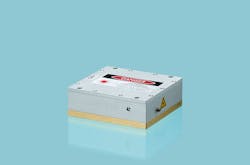The FQ-Series medical laser from LIMO (Dortmund, Germany) with a 1470 nm wavelength offers a parallel wavelength of 980, 940 or 810 nm, making higher absorption possible in water and hemoglobin. The fiber-coupled laser offers a 15 and 30 W power rating, with >100 W available on request. Features include a protective window, fiber contact switch, monitor diode and pilot laser.
-----
PRESS RELEASE
At the BIOS 2011 (booth 8601) LIMO presents the particularly compact diode laser with a wavelength of 1470 nm that has been supplemented by an additional parallel wavelength: 980 nm, 940 nm or 810 nm. This long established standard wavelength on the medical market, combined with the expedient wavelength of 1470 nm, can be individually controlled. The power rating of the fiber-coupled laser is 15 W and 30 W. On request, a power rating of >100 W can also be supplied.
The dimensions of the potential-free housing are greatly reduced but, however, completely equipped: protective window, fiber contact switch, monitor diode and pilot laser are already integrated. The combination of a compact design with all additional and safety features makes it suitable for integration into OEM appliances, without causing additional development and production costs. Furthermore, the high-performance laser module makes it possible for the end user to operate at practically all working and ambient temperatures and in nearly all operating modes of cw up to the most varied pulsed conditions.
Without exception, the LIMO diode laser modules are maintenance-free, so that flexible warranty periods can be provided. This has the advantage that costs are completely eliminated in the event of replacement.
The product is optimally suitable in the end use for medical treatment in the field of modern surgery and urology. The two wavelengths make higher absorption possible of the laser in water and haemoglobin. In addition to the high removal rates, the treatment can be carried out ambulant, quick and with care. Further advantages for operative treatment are:
- safe and high precision treatment (less bleeding, protection of the adjacent tissue)
- minimum postoperative complaints
- quick, uncomplicated healing (no stitches)
For further information, refer to www.limo.de or Andre Grütz, [email protected].
